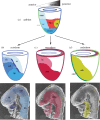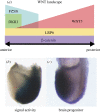Initiating head development in mouse embryos: integrating signalling and transcriptional activity
- PMID: 22754658
- PMCID: PMC3382960
- DOI: 10.1098/rsob.120030
Initiating head development in mouse embryos: integrating signalling and transcriptional activity
Abstract
The generation of an embryonic body plan is the outcome of inductive interactions between the progenitor tissues that underpin their specification, regionalization and morphogenesis. The intercellular signalling activity driving these processes is deployed in a time- and site-specific manner, and the signal strength must be precisely controlled. Receptor and ligand functions are modulated by secreted antagonists to impose a dynamic pattern of globally controlled and locally graded signals onto the tissues of early post-implantation mouse embryo. In response to the WNT, Nodal and Bone Morphogenetic Protein (BMP) signalling cascades, the embryo acquires its body plan, which manifests as differences in the developmental fate of cells located at different positions in the anterior-posterior body axis. The initial formation of the anterior (head) structures in the mouse embryo is critically dependent on the morphogenetic activity emanating from two signalling centres that are juxtaposed with the progenitor tissues of the head. A common property of these centres is that they are the source of antagonistic factors and the hub of transcriptional activities that negatively modulate the function of WNT, Nodal and BMP signalling cascades. These events generate the scaffold of the embryonic head by the early-somite stage of development. Beyond this, additional tissue interactions continue to support the growth, regionalization, differentiation and morphogenesis required for the elaboration of the structure recognizable as the embryonic head.
Keywords: gene transcription; head formation; morphogenesis; mouse embryo; signalling.
Figures





Similar articles
-
Modulation of WNT signaling activity is key to the formation of the embryonic head.Cell Cycle. 2012 Jan 1;11(1):26-32. doi: 10.4161/cc.11.1.18700. Epub 2012 Jan 1. Cell Cycle. 2012. PMID: 22157093
-
Dissecting the dynamics of signaling events in the BMP, WNT, and NODAL cascade during self-organized fate patterning in human gastruloids.PLoS Biol. 2019 Oct 15;17(10):e3000498. doi: 10.1371/journal.pbio.3000498. eCollection 2019 Oct. PLoS Biol. 2019. PMID: 31613879 Free PMC article.
-
Control of early anterior-posterior patterning in the mouse embryo by TGF-beta signalling.Philos Trans R Soc Lond B Biol Sci. 2003 Aug 29;358(1436):1351-7; discussion 1357. doi: 10.1098/rstb.2003.1332. Philos Trans R Soc Lond B Biol Sci. 2003. PMID: 14511481 Free PMC article.
-
Gastrula organiser and embryonic patterning in the mouse.Semin Cell Dev Biol. 2004 Oct;15(5):543-54. doi: 10.1016/j.semcdb.2004.04.005. Semin Cell Dev Biol. 2004. PMID: 15271300 Review.
-
Dose-dependent Nodal/Smad signals pattern the early mouse embryo.Semin Cell Dev Biol. 2014 Aug;32:73-9. doi: 10.1016/j.semcdb.2014.03.028. Epub 2014 Apr 1. Semin Cell Dev Biol. 2014. PMID: 24704361 Review.
Cited by
-
An efficient simplified method for the generation of corneal epithelial cells from human pluripotent stem cells.Hum Cell. 2022 Jul;35(4):1016-1029. doi: 10.1007/s13577-022-00713-5. Epub 2022 May 12. Hum Cell. 2022. PMID: 35553384
-
A gastruloid model of the interaction between embryonic and extra-embryonic cell types.J Tissue Eng. 2022 Jun 11;13:20417314221103042. doi: 10.1177/20417314221103042. eCollection 2022 Jan-Dec. J Tissue Eng. 2022. PMID: 35707767 Free PMC article.
-
Expression and evolution of the Tiki1 and Tiki2 genes in vertebrates.Int J Dev Biol. 2014;58(5):355-362. doi: 10.1387/ijdb.140106ja. Int J Dev Biol. 2014. PMID: 25354456 Free PMC article.
-
The ZIC gene family encodes multi-functional proteins essential for patterning and morphogenesis.Cell Mol Life Sci. 2013 Oct;70(20):3791-811. doi: 10.1007/s00018-013-1285-5. Epub 2013 Feb 27. Cell Mol Life Sci. 2013. PMID: 23443491 Free PMC article. Review.
-
PRDM15 interacts with DNA-PK-Ku complex to promote radioresistance in rectal cancer by facilitating DNA damage repair.Cell Death Dis. 2022 Nov 19;13(11):978. doi: 10.1038/s41419-022-05402-7. Cell Death Dis. 2022. PMID: 36402747 Free PMC article.
References
-
- Rossant J, Tam PP. 2004. Emerging asymmetry and embryonic patterning in early mouse development. Dev. Cell 7, 155–16410.1016/j.devcel.2004.07.012 (doi:10.1016/j.devcel.2004.07.012) - DOI - DOI - PubMed
-
- Tam PP, Gad JM. 2004. Gastrulation of the mouse embryo. In Gastrulation (ed. Stern C. D.), pp. 223–262 Cold Spring Harbor, NY: Cold Spring Harbour Laboratory Press
-
- Tam PP, Loebel DA. 2007. Gene function in mouse embryogenesis: get set for gastrulation. Nat. Rev. Genet. 8, 368–38110.1038/nrg2084 (doi:10.1038/nrg2084) - DOI - DOI - PubMed
-
- Tam PP. 1989. Regionalisation of the mouse embryonic ectoderm: allocation of prospective ectodermal tissues during gastrulation. Development 107, 55–67 - PubMed
-
- Cajal M, Lawson KA, Hill B, Moreau A, Rao J, Ross A, Collignon J, Camus A. 2012. Clonal and molecular analysis of the prospective anterior neural boundary in the mouse embryo. Development 139, 423–43610.1242/dev.075499 (doi:10.1242/dev.075499) - DOI - DOI - PMC - PubMed
Publication types
MeSH terms
Substances
LinkOut - more resources
Full Text Sources
Other Literature Sources

